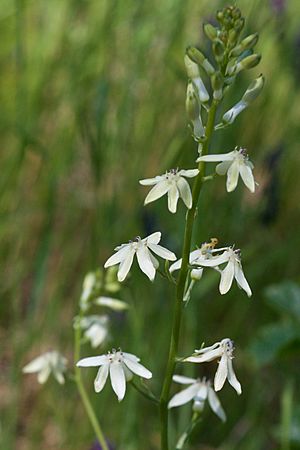Hartweg's doll's-lily facts for kids
Quick facts for kids Hartweg's doll's-lily |
|
|---|---|
 |
|
| Scientific classification |
Odontostomum hartwegii, also known as Hartweg's doll's-lily, is a special kind of flowering plant. It's the only species in its plant group, called a genus, named Odontostomum. This means it's quite unique! It belongs to the plant family called Tecophilaeaceae. Long ago, it was thought to be part of the lily family (Liliaceae).
Contents
Hartweg's Doll's-Lily: A Unique California Plant
Hartweg's doll's-lily is a wildflower that is only found in a specific area. This means it is endemic to northern California. You can spot it growing in the inner coastal mountains and the Sierra Nevada foothills.
Where Does This Plant Live?
This plant likes to grow in tough places! It often lives in rocky clay soils. Sometimes, it even grows in a special type of soil called serpentine soil. You can find it in open grasslands and wooded areas. It sometimes grows near vernal pools, which are temporary pools of water that appear after rain.
What Does Hartweg's Doll's-Lily Look Like?
Hartweg's doll's-lily is a perennial herb. This means it's a plant that lives for more than two years and doesn't have a woody stem. It grows from an oval-shaped corm, which is like a small, underground bulb. This corm can be up to 3 centimeters wide and is buried deep in the soil.
Stems and Leaves
The plant has a stem that curves and branches out widely. It can grow up to about half a meter tall. Its leaves are long and thin, reaching up to 30 centimeters in length. These leaves wrap around the lower part of the stem.
Flowers and How They Grow
The flowers of Hartweg's doll's-lily grow in a cluster called an inflorescence. This cluster can be a raceme or a panicle, which are different ways flowers can be arranged on a stem. Several flowers grow on small stalks called pedicels.
Each flower has six white or yellowish parts called tepals. These tepals are like petals and sepals combined. The bottom parts of the tepals are joined together to form a tube with visible veins. The tips of the tepals spread out and then curve backwards. In the center of the flower, you'll find six stamens, which produce pollen. There are also six staminodes, which look like stamens but don't produce pollen. These are all arranged in a ring around the gynoecium, which is the part of the flower that will become the fruit.

